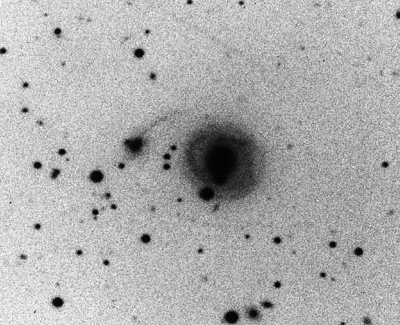Another “lesser known” example of discordant redshifts from the southern hemisphere is AM 2052-221 which is also listed in Dr. Halton Arp’s and Barry Madore’s A Catalogue of Southern Peculiar Galaxies and Associations (Cambridge University Press, 1987). It is also listed as AM 2054-2210 in Dr. Arp’s book Quasars, Redshifts and Controversies (Interstellar Media, 1987) and his articles published in Volume 236 and Volume 239 of the The Astrophysical Journal in 1980 and in a 1981 supplement. Again, as with NGC 1347, the best image I could find for this pair of objects is a photograph taken with the 48-inch UK Schmidt Telescope in New South Wales, Australia sometime in the 1970’s. I have cropped the original image a bit in order to fit it on this page but it is otherwise unaltered.
As with many of the Schmidt Telescope photographs of the time the image quality is somewhat grainy. However, it can be clearly seen that the smaller of the two objects is trailing a stream of material that curves back toward the larger object possibly connecting to it within the diffused arm on the larger object’s north side. But this begs the same question as with NGC 1347. If they are physically connected how can their measured redshifts be so incredibly discordant?  NED lists the redshift of the larger galaxy at 0.034377 z which would place its distance at over 595 million light-years from Earth using a so-called Hubble Constant value of 55 (km/s)/Mpc. The smaller object is listed as having a redshift of 0.156215 z. This indicates a supposed distance of almost 2.488 billion light-years from Earth. This is over 4 times the distance of the larger object!
NED lists the redshift of the larger galaxy at 0.034377 z which would place its distance at over 595 million light-years from Earth using a so-called Hubble Constant value of 55 (km/s)/Mpc. The smaller object is listed as having a redshift of 0.156215 z. This indicates a supposed distance of almost 2.488 billion light-years from Earth. This is over 4 times the distance of the larger object!
Because of the poor quality of the photographs available today one could argue that there is no clear connection between AM 2052-221 and its companion object. But if there is a connection, the implications in regards to the assumed meaning of extragalactic redshifts and their supposed relationship to the Big Bang Theory is so great that one would think that better observations would have been made by now. Yet, as with NGC 1347, the best image I could find came from observations made over thirty years ago from a telescope less than a quarter of the size of those available today. Once again I was unable to find any images of from any modern large telescope that covers the southern hemisphere including the SALT, the Gemini South or even the HST. In the little time I have had to research procuring observational data from some of the world’s largest telescopes I have learned that it is an extremely tedious and arduous process that is obviously not geared toward the casual astronomer. However I will continue to pursue new data and I will report any new findings. I still believe the powerful optics of these telescopes could one day help finally bring to light the true connection between extragalactic objects and the true meaning of their discordant redshifts.
And as always, I encourage all visitors to this site to pursue their own observations and feel free to contribute to those posted here or even submit new ones.
Thanks for reading!
Shannon
Tags: A Catalogue of Southern Peculiar Galaxies and Associations, AM 2052-221, AM 2054-2210, Atlas of Peculiar Galaxies, Barry Madore, Halton Arp, The Astrophysical Journal, UK Schmidt Telescope

Thank you for your website which makes this information easier to find. After reading about Halton Arp’s work I wanted to look at some of the photos of galaxies that appear linked to quasars with different redshifts, and I am glad to have found such examples here.
It does look suspect to me as well that these apparent couplings have not been investigated further in the decades since Dr Arp’s original studies.
Thanks again and best wishes!